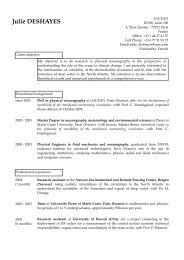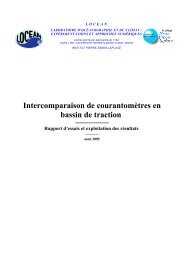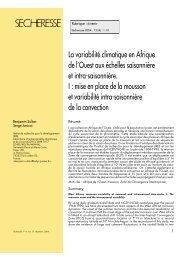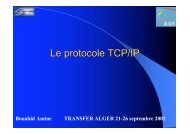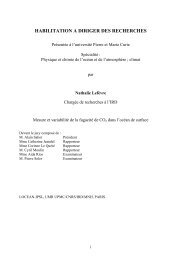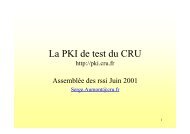PISCES biogeochemical model - NEMO
PISCES biogeochemical model - NEMO
PISCES biogeochemical model - NEMO
Create successful ePaper yourself
Turn your PDF publications into a flip-book with our unique Google optimized e-Paper software.
The half-saturation constant of iron varies following the same parameterization as for nanophytoplankton<br />
(see Eq. 4).<br />
The diatoms aggregation term wp<br />
diat is increased in case of nutrient limitation beacause it<br />
has been shown that the diatoms cells become more sticky in case of nutrient stress:<br />
w diat<br />
p<br />
= w min<br />
p<br />
+ w max<br />
p<br />
× (1 − L diat<br />
lim )<br />
Furthermore as for nanophytoplankton, the aggregation is multiplied by the shear rate.<br />
3.3 Equation for chlorophyll in phytoplankton<br />
∂I Chl<br />
∂t<br />
= ρ I Chl(1 − δ I )µ I I − m I I<br />
K I + I IChl<br />
−w I pII Chl − g micro (I)θ I ChlZ − g meso (I)θ I ChlM (8)<br />
where I is the phytoplankton class and θChl I is the chlorophyll-to-carbon ratio of the considered<br />
phytoplankton class. ρ I Chl represents the ratio of energy assimilated to energy absorbed as<br />
defined by Geider et al. (1996):<br />
ρ I Chl = 144µ I I<br />
θI Chl,max<br />
(9)<br />
α I × P AR × I Chl<br />
In this equation, 144 is the square of the molar mass of C and is used to convert from mol<br />
to mg as the standard unit for Chl is generally in mg Chl/m 3 .<br />
For the iron content of phytoplankton, a similar approach is used as iron is related to the<br />
photosynthetic apparatus. Thus, the equations are exactly equivalent to equation 8. Furthermore,<br />
this parameterization predicts an Fe:C ratio whose variations are consistent with the<br />
observations: this ratio decreases with light and with the nutrient stress including iron.<br />
3.4 Equation for the silicon content of diatoms<br />
∂D Si<br />
∂t<br />
( ) Si opt<br />
= (1 − δ 2 )µ diat D − m diat D<br />
C<br />
K diat + D DSi<br />
−wP<br />
diat DDSi − (g micro (D)Z + g meso (D)M)<br />
( ) D<br />
Si<br />
D<br />
(10)<br />
Where the ( Si<br />
C )opt ratio is diagnostically defined from Bucchiarelli et al. (2002) as:<br />
( Si<br />
C<br />
α D ( Chl<br />
C<br />
)D P AR<br />
Lim = min((1 − e µ D L diat<br />
lim ), L diat<br />
po4 , Ldiat F e , Lnano no3 + L nano<br />
nh4 )<br />
) opt<br />
= 0.151L diat<br />
Si (5.4e F Lim Si<br />
+ 1.13) (11)<br />
F Si<br />
Observations have shown that diatoms in the southern ocean are more heavily silicified than<br />
anywhere else. This increase can not be explained only by the light or the iron stress as the<br />
5





